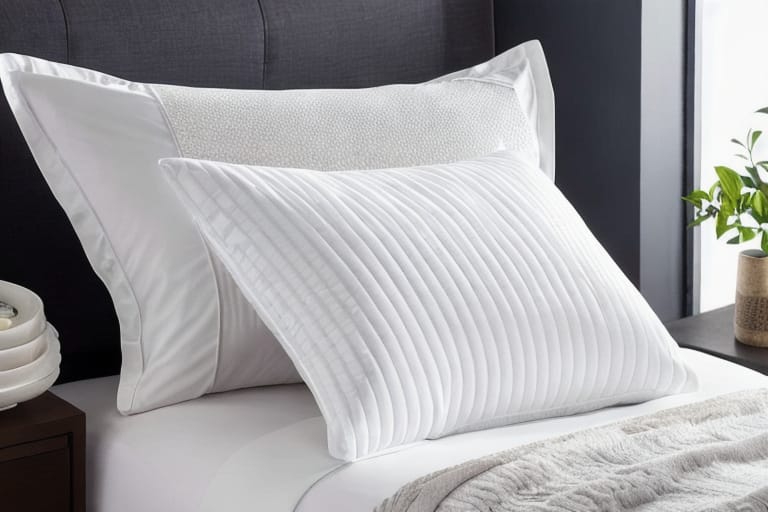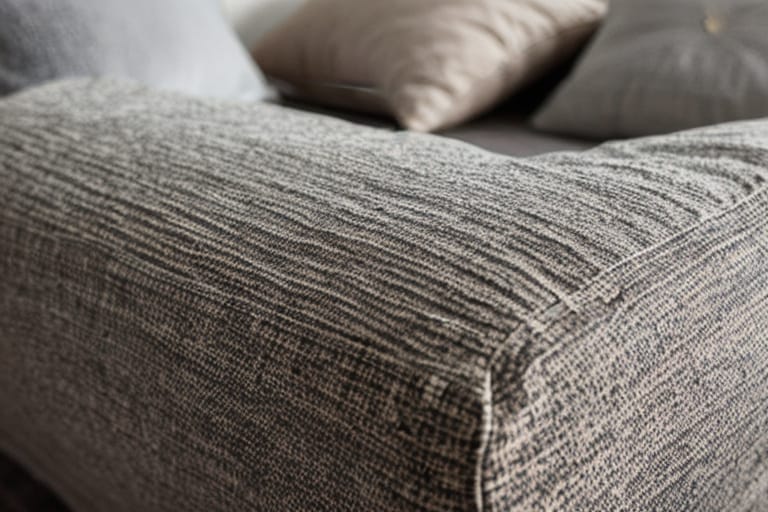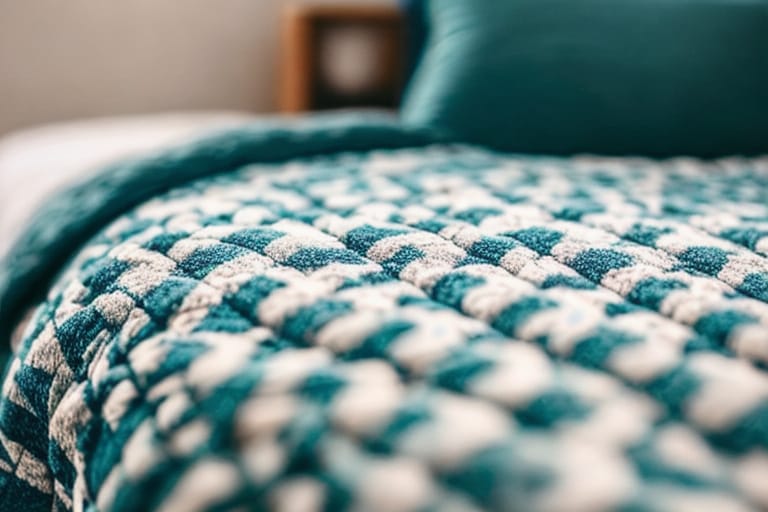Down comforters are known for being wonderfully warm and cozy. But the fill that makes them so uniquely comfortable—goose down—also makes traditional down comforters unsuitable for certain people, namely those with feather allergies or who follow vegan lifestyles.
Down alternative comforters provide a solution—delivering the comforting weight and heat you love without the allergy-aggravating properties of natural down or issues around animal welfare.
But how well do these synthetic comforters mimic the exceptional comfort and insulation of high-quality down? And how can you know if one will suit your needs and sleep preferences? This beginner’s guide tells you everything you need to know about down alternative comforters so you can determine if they deserve a spot on your bed.
What Is a Down Alternative Comforter?
A down alternative comforter looks and feels much like a regular down comforter with a lightly weighted, puffy filling encased in a sewn outer shell that keeps the fill in place inside your duvet cover. But down alternative comforters fill this outer shell with synthetic materials instead of goose or duck down.
The most common down alternative fill materials include:
- Polyester fibers – Usually made from recycled plastic bottles and shaped into clusters that mimic down clusters to trap heat.
- Rayon fibers from bamboo or other sources – Light, breathable fibers with moisture-wicking properties.
- Microdenier fibers – Thin, velvety-soft synthetic fibers.
- Tencel lyocell – Highly breathable fabric made from sustainable tree pulp. Used as a cover material.
These fill materials replicate some of the key qualities of down, like softness, insulation ability, and compression resistance. But unlike down, the synthetic alternatives remain hypoallergenic and vegan.
How Do Down & Down Alternative Comforters Compare?
Down and down alternative comforters share some similarities but also have crucial differences, summarized in this table:
| Goose or Duck Down Comforters | Down Alternative Comforters | |
|---|---|---|
| Fill Material | Down and small feathers from ducks or geese | Synthetic fills like polyester, rayon, or Tencel lyocell fibers |
| Allergen-Free? | No, contains allergens | Yes, hypoallergenic |
| Vegan? | No, animal-based | Yes, synthetic materials |
| Softness | Very soft, fluffy | Close to down but can be less uniformly soft |
| Warmth & Breathability | Excellent, lofty fill traps air | Good, replicates down well. Depends on fill quality |
| Durability | Excellent if high fill power | Variable depending on materials |
| Ease of Care | Dry clean or gentle machine wash/dry | Often machine washable and dryable |
| Affordability | More expensive | Wide range but often cheaper |
As you can see, down and down alternative comforters overlap in desired qualities like softness, comfort, breathability, and longevity. But they diverge when it comes to allergen potential, ethics for vegans/vegetarians, and care requirements.
For shoppers with feather allergies or strict budgets, alternatives beat natural down. But those seeking unmatched softness and durability may want true goose down if allergen concerns don’t apply.
Fill Power and Down Alternative Performance
Fill power—which indicates the loft and therefore warmth of down—doesn’t apply precisely the same way to down alternatives. But you can still use the fill power descriptions as a rough guide for the expected warmth and puffiness of the synthetic fill.
- Low fill power (under 400): More affordable but less insulation and durability. Best suited for warm climates.
- Medium fill power (400 to 600): Balances cost and performance nicely for most regions. Provides better heat retention while remaining budget-friendly.
- High fill power (over 600): Maximum warmth and plush feel replicating premium down. But pricier. Ideal for cold regions or chilly sleepers.
Aim for the highest fill power you can afford. Even budget-priced down alternative comforters now often reach 600+ fill power thanks to improved manufacturing techniques for synthetic fibers.

Factors to Consider When Selecting a Down Alternative Comforter
Fill power dictates warmth, but other factors also contribute to overall comfort and suitability for your needs:
1. Shell Material
The outer shell enclosing the down alternative fill impacts durability, breathability and ease of cleaning. Quality materials include:
- Cotton – Very breathable and machine washable but less durable over time
- Polyester – Colorfast, durable, and mostly machine washable but can trap heat
- Tencel – Extremely soft, breathable, durable and sustainable
2. Stitching
Double or baffle-box stitching prevents fill shifting and clumping over time. Reinforced seams also boost durability.
3. Fill Weight
This personal preference affects warmth. Measure by ounces per square yards (osy) with options spanning from light to heavy:
- Lightweight: under 16 osy
- Midweight: 16-22 osy
- Heavyweight: over 22+ osy
4. Fill Distribution
Uniformly distributed, full chambers ensure even warmth and support. Avoid thin spots or dense sections.
5. Return Policies
Trying a comforter at home helps assess warmth, softness and quality. Look for satisfaction guarantees of 30 days or longer.
Who Benefits Most from a Down Alternative Comforter?
While virtually anyone can enjoy their allergen-free comfort, individuals most likely to favor down alternative bedding include:
Allergy Sufferers
The hypoallergenic nature of down alternatives makes them ideal for those with sensitivities. They contain no allergens from feather dust or dander.
Hot Sleepers
The synthetic materials breathe exceptionally well, preventing heat buildup for those prone to overheating or night sweats.
Vegans & Vegetarians
Down alternative comforters align with vegan ethics, using only plant-based materials or synthetics from non-animal sources during manufacturing.
Budget Buyers
Quality synthetic fills make down alternatives far more affordable than luxury goose down comforters, with some starting under $50.
Care and Cleaning of Down Alternative Comforters
Caring properly for a down alternative comforter ensures it retains its heat-trapping loft and softness over years of use:
- Follow any special washing instructions from the manufacturer, like water temperature or dryer settings.
- Use a large capacity machine if home washing to allow adequate space.
- Low heat tumble drying helps re-fluff fills after washing.
- Periodic shaking or fluffing maintains even distribution and loft.
- Store folded loosely in breathable cotton cases during warmer months.
5 Top-Rated Down Alternative Comforters
The down alternative market keeps improving alongside advances in synthetic fabrics. With dozens of brands now offering quality comforters, it helps to focus on bestsellers with high user ratings and reviews.
Five down alternative comforters rise to the top for value, construction and owner satisfaction:
| Brand & Model | Rating | Price | Benefits |
|---|---|---|---|
| Utopia Bedding Comforter | 👍👍👍👍💫 4.5 out of 5.0 | $29-60 | Value Pick Hotel-style quality at an unbeatable price |
| Linenspa All-Season White Down Alternative Quilted Comforter | 👍👍👍👍 4.3 out of 5.0 | $30-60 | Lightweight Pick Corner tabs prevent shifting |
| AmazonBasics Reversible Microfiber Comforter | 👍👍👍💫💫 4.6 out of 5.0 | $23-35 | Easy Care Pick Machine washable & 5 colors |
| Puredown Coolmax Down Alternative Comforter | 👍👍👍👍 4.7 out of 5.0 | $70-140 | Fluffy Luxury Pick Mimics premium down feel |
| RECcIt Bliss 40 oz Down Alternative Queen Comforter | 👍👍👍💫💫 4.7 out of 5.0 | $60-100 | Weighty Warmth Pick Heavyweight for extra coziness |
As you assess your needs and budget, the above represent top options to consider that balance quality, affordability and owner experiences.

FAQs: Key Questions Answered
What about down alternative comforters commonly puzzles or concerns shoppers? Below we address some of the top frequently asked questions:
Are down alternative comforters actually warm?
- Yes, the best maintain impressive warmth thanks to technical synthetic fills that trap heat nearly equivalent to quality goose down. But warmth does depend somewhat on fill power, weight and materials.
Do they leak tiny fibers you can inhale?
- Low-quality fills with loose fibers and weak outer shells can leak over time. Premium brands densely weave quality synthetic shells to eliminate leakage potential.
Which fills mimic down the closest?
- For softness and efficient heat-trapping, recycled polyester microfibers are tough to tell from high-end goose down.
How long do they last?
- Around 5-10 years is typical but premium materials like Tencel shells and high-denier microfibers substantially extend longevity if cared for properly.
What’s the benefit over lighter blankets?
- The evenly dispersed weight provides pressure that many find comforting. More fill also means better insulation from the cold. Plus outer shells prevent shifting.
Weigh Your Options Carefully
When woven from quality materials at optimal fill densities, today’s down alternative comforters can indeed provide allergy-free, animal-friendly bedding without sacrificing much comfort or heat.
As production methods and fabrics continue advancing, down alternatives look to cover any slight gaps remaining versus natural goose down for most consumers. Just keep quality, fill power and materials front of mind when comparing specific products to find the ideal balance of coziness, longevity and breathability suiting your lifestyle. Carefully weighing these factors helps ensure whichever route you take leads to countless nights of peaceful slumber.








